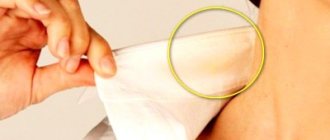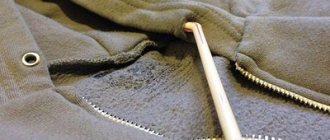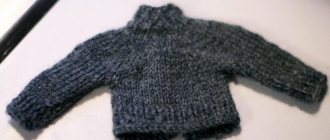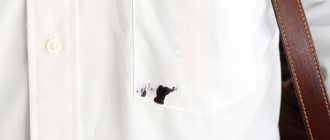Shirts have long won their place in the closet of both men and women. They are worn both on weekdays and on special occasions.
It is important that the item not only fits in size and style, but also looks great. Otherwise, the reputation of its owner may suffer greatly - no one will want to deal with an unkempt person in a wrinkled, unwashed shirt.
In order for this wardrobe item to retain its appearance and color for a long time, it is necessary to take proper care of it. After all, improper washing of a product can simply ruin it, and to prevent this from happening, you need to know how to wash a white and colored shirt.
How to whiten white shirts: 10 traditional methods
Using store-bought bleaches is not always a rational decision.
Modern housewives know in practice how difficult it is to choose a bleaching agent using trial and error.
Selecting an effective substance for your home arsenal of household chemicals can be difficult for several reasons:
- high cost;
- short duration of effect;
- disappearance of a proven product from store shelves.
Modern housewives know in practice how difficult it is to choose a bleaching agent using trial and error without spoiling a single thing. Affordable and cheap materials will come to the aid of lovers of freshness and cleanliness.
Laundry soap
A solution prepared on the basis of laundry soap has been used in everyday life since time immemorial.
To combat gray color, use brown soap; there are two options for preparing a product based on it:
- Systematically collect soap residues in a glass container. First pour a small amount of water into it for quick swelling. Add liquid as soap accumulates. This option is suitable for bleaching shirts and blouses made of all types of fabric.
- Add 2 pieces of laundry soap without additives to a liter of water, after grating the soap. Leave to swell for 30-60 minutes. Place on low heat. Stir occasionally, avoid boiling the solution. Keep until completely dissolved and a homogeneous mass is obtained.
Vodka with glycerin
It is recommended to soak the item in a solution based on vodka, glycerin and water. For 1 liter of water you will need 300 ml of glycerin and 400 ml of vodka. After thoroughly mixing the ingredients, the product is soaked for half an hour in the resulting solution.
Afterwards you should wash it by hand and rub it with laundry soap. Then send the item to the machine (the mode is set in accordance with the manufacturer’s requirements). Washing is done with the addition of powder with a bleaching effect. If desired, you can add conditioner.
On a note! Using store-bought bleaches or stain removers is not always safe for items. Before using aggressive substances that promise easy removal of dirt, carefully read the tags on things and the instructions for using a particular product.
Potassium permangantsovka
The method is effective, but dangerous.
Using store-bought bleaches or stain removers is not always safe for items.
It should be used carefully, monitoring the concentration of the solution, making sure to completely dissolve the crystals in the liquid:
- Preheat the water to 75-80 °C.
- Pour manganese into water. The color of the resulting liquid should be slightly pink.
- Add washing powder (1 tablespoon of detergent per 2 liters of water).
- Soak a shirt, dress or other item made of white fabric.
- Close the basin with things tightly.
- Keep in the solution until the manganese-washing liquid cools.
- After use, pour out the potassium permanganate and rinse things 2-3 times.
Read more ► Washing tulle to make it snow-white, choosing products, temperature and program
Hydroperite
To remove yellowness from linen, you can purchase hydroperite at the pharmacy. For 5 liters of water you will need 5 tablets of hydroperite (for convenience, crush them into powder) and 3 tbsp. l. washing powder. The water should be warm. Pre-soak things in this solution.
Afterwards, the blouse, dress or shirt will need to be washed and left for a quarter of an hour. Without rinsing, transfer to the drum, add bleach and washing gel. Select the mode in accordance with the fabric care requirements.
Boric acid
Many whitening products cannot always cope with their task.
Experienced housewives recommend using another pharmacy option. Add 40 ml of acid to 4 liters of water. Leave the fabric in the solution for 3 hours and rinse.
If the stain is not completely removed, spin the item again in the machine with powder or gel.
Sodium perborate
Wool clothing requires a special approach; sodium perborate is a good option for caring for it. Heat 2 liters of water to 40-45 °C, add 150 ml of product. Keep the product in the mixture for a quarter of an hour, then wash it, adding conditioner.
Vinegar
Pure vinegar cannot be used, but if you combine it with tar soap and soak clothes for an hour, the result will exceed expectations.
For the bleach you will need:
- cling film as a cover, protection against air penetration;
- 70 ml table vinegar 9%;
- 2 liters of water, heated to 30 °C.
The duration of soaking is 1 hour. After the time has passed, squeeze out, rub with soap, and spin on intensive mode in the washing machine.
On a note! Before using the chosen method of eliminating stains, it is strongly recommended to rinse the items in cold water. This will help remove dust and prevent the appearance of grayness.
Milk
Whitening using milk powder has earned the recognition of housewives. 200 g of dry product are diluted in 4 liters of water. Things are soaked in the solution for about 40-45 minutes, then washed in the usual way.
Lemon acid
Citric acid can restore the whiteness of things.
Citric acid can restore the whiteness of things . Both natural lemon juice and dry mixture will do. Before applying the acid, the contamination is wetted. Next, apply citric acid and rub in well. After waiting half an hour, the item is washed.
Soda
The product used for baking will get rid of stains on clothes and yellowing. No pre-soaking required. Simply pour equal amounts of washing powder and baking soda into the appropriate compartment and select the normal wash cycle.
The second way to remove stains is to use slaked soda and vinegar. The components taken in equal parts are applied to the fabric in the form of a foamy mass.
5 more tips
If you notice that the item has turned gray or a pale yellow spot has appeared on it, do not put off washing it. The sooner you start acting, the greater the chances of returning the whiteness to your shirt. The following five tips will help maintain color and texture.
- Do not overdo it. All bleaches (including household bleaches) destroy fibers and make fabric less durable. Therefore, you cannot add them every time you wash. The optimal frequency is once every three to four sessions.
- Read the instructions. If you use store-bought bleaches, follow the recommended dosage. It is advisable to purchase a measuring cup. If you use too little product, the effect will not be noticeable. A large amount of bleach will ruin the fabric.
- Sort things. Always wash white items separately, otherwise shirts may suffer from shedding.
- Observe temperature conditions. Maintaining the correct temperature is important for successful whitening. So, for cotton fabric the optimal temperature is 70°C. If you need to wash a white silk blouse, do not heat the water above 40°C.
- Check the capacity. If you use an enamel basin for washing, make sure that it is not damaged. Because of them, rust can get on the white fabric.
When sorting clothes during washing, it is important to consider not only the color, but also the type of fabric. This is due to the need to comply with the washing temperature regime.
A white shirt is a universal item. Can be worn to work or for a walk, combining with any wardrobe items. To be at your best, you need to keep it in perfect condition. Knowing how to bleach a white blouse and shirt with affordable means, you will save yourself from the need to buy expensive household chemicals.
How to remove yellowness from a shirt collar
Collars and cuffs require special care. They retain traces of perfume, food, liquid, sebum, dust and dirt from tables. The stains are firmly embedded in the material.
Collars and cuffs require special care
Only 4 whitening options can remove the consequences of a working day:
- Talcum powder . Contaminated areas are moistened abundantly and covered with a layer of talc. If it is heavily soiled, you need to rub it gently. Leave for 6-8 hours, wash as usual. Talc is often replaced with chalk without additives.
- The soda-vinegar mixture saves white collar faster than the previous method. The foam mass is applied to dirty places. Leave for 7-10 minutes. and wash it.
- You can also clean the stained area with citric acid Cover the stain with it for 15-20 minutes. Then wash according to the recommendations on the product label.
- laundry soap gel liberally to the surface, leave for 1-2 hours, and wash.
Read more ► How to bleach nylon tulle from gray and yellowness, the best way, reviews
Bleaching with potassium permanganate
A small strategic supply of potassium permanganate will ideally whiten white shirts. To prepare the solution you will need:
5 liters of hot water; 200 g washing powder; a few crystals of potassium permanganate (the water should turn light pink).
Place a cloth that has been pre-washed from normal stains into the mixture and tightly cover the container with a lid. Leave the shirt soaked in the solution until the mixture cools to room temperature. Rinse clothes thoroughly.
Household bleaches
Not everyone wants to resort to traditional methods of removing yellowness, grease stains and dirt in order to save white things. It's easier to use chemical compounds.
There is a division into chlorine-containing and oxygen-containing agents:
| Substances | pros | Minuses | Examples |
| Chlorine-containing | Quick results | Aggressive, corrode matter | "Chlorine" |
| Small quantity to use | Acrid odor, can burn mucous membranes | "White" | |
| Acceptable price | Hand and face protection required | "Domestos" | |
| Not suitable for thin materials and underwear | |||
| Oxygen | Hypoallergenic | The result is not always at a high level | "Vanish" |
| Can bleach delicate fabrics, underwear | Expensive | "Ecover" | |
| Suitable for all types of material |
Need to know! A new type of brightener has appeared - optical liquid. It visually removes dirt, the effect lasts up to 8 hours, which is enough for a working day. An example of a product is Belotex.
Methods for cotton fabrics
A shirt made of cotton fabric is convenient and comfortable, but dirt appears on it quickly. Problems can be eliminated by boiling or bleaching with soap or aggressive substances.
You should be more careful with “chemistry”, because... it destroys not only dirt, but also cotton.
Boiling
Applicable for shirts made of durable material. For boiling, dilute 3 tbsp in 5 liters of water. l. powder. Bring to a boil, then reduce the heat, simmer for half an hour, stirring.
Attention! Frequent boiling deforms things, so do not overuse it.
Whitening with laundry soap
Bleaching with laundry soap
This method guarantees the preservation of the shape of the cotton product. Both soap gel and the option of rubbing contaminated areas are used.
The product must be applied generously. Afterwards, put the items in a plastic bag (transparent, without a pattern) and tie it tightly so that air does not penetrate inside. Leave for up to 24 hours and rinse.
Important! Lightening of yellowed material is achieved by soaking in a mixture of hydrogen peroxide and ammonia. You can keep things to bleach in it for no more than 25-30 minutes.
Rules and precautions
Before returning the fabric to whiteness, you should read the information on the clothing label (triangle image). It indicates whether the item can be bleached, the preferred method and temperature of the process.
| Triangle sign | Meaning |
| Empty | Bleaching allowed |
| Crossed out | The use of bleach is prohibited |
| Inside which is written CL | Chlorine bleaches can be used |
| With two stripes inside. Crossed out with CL written inside | It is prohibited to use preparations containing chlorine |
When choosing a bleaching method, you should always consider what material the shirt is made of. The most durable fabrics are linen and cotton; they can be bleached using chlorine-containing products. For other materials, aggressive bleaches cannot be used. For the process to be effective, you need to follow the following precautions:
- white shirts should be soaked at home in plastic containers, not metal;
- You should check your pockets to ensure that no objects are accidentally left there;
- shirts with metal fittings (buttons, snaps, decorative elements) are soaked in cool, barely warm water;
- Abuse of bleaching leads to the fact that any fabric becomes shabby over time, so bleach is used no more than every third or fourth wash.
To whiten white shirts without ruining them, you can do a test: apply the product to an inconspicuous area of clothing, for example, inside a cuff or collar. After the time specified in the instructions, you can evaluate the result.
Soak white shirts in a plastic container
Check pockets before washing
shirts with metal fittings are soaked in cool water
Bleach is used no more than every third or fourth wash.
Linen clothing
Linen is easy to bleach.
It is suggested to use one of the following methods:
- To get rid of gray plaque, it is recommended to add 2 tbsp when washing. l. salt.
- To lighten, soak linen shirts and blouses in soda water. Mix 0.5 kg of soda in 5 liters of liquid. Before use, soak the solution for 24 hours and strain. This product can be stored in a glass container for a long time.
- Turpentine will help make the fabric snow-white. For 1 liter of water add 1 tbsp. l. substances. Soak things for at least 10-12 hours.
- Yellowness can be eliminated with ammonia diluted in water. To do this, add 1 tbsp to a liter of liquid. alcohol
- The last method is vinegar 9%. Pour 100 ml of vinegar into 2 liters. Soak the laundry for 3 hours and wash.
Read more ► How to wash towels: effective ways to bleach and clean terry materials
Preparing for washing
Before you start washing men's shirts, you need to prepare them. The first thing to do is sort things by color.
After all, white and colored linen are washed separately. A white shirt may become stained by a colored item and be ruined.
It is also necessary to carefully study the label of the shirt, because not all items can be washed in a machine.
If there are no restrictions, then you should look for complex stains and treat them manually, for example, with a stain remover.
Remember, a washing machine may not be able to handle serious stains on its own.
Then you need to fasten all the buttons on the shirt. This simple procedure allows you to avoid unnecessary deformation of items during washing.
And of course, don’t forget to look in your pockets, in case there is money, a card or other small items lying around. If you find trash, shake it out.
Lightening of synthetics
Synthetic fabrics are one of the most delicate materials.
Use the following tools:
- Aspirin . For 1 shirt you need to take 2-3 tablets. Grind to a powder. Rub into damp cloth. Wash after achieving the desired result.
- Potato . Peel the tuber, cut in half. Rub the desired areas well. Wait until completely dry. Get rid of remaining starch with a brush. After such treatment, wash items in the standard way.
Available means
When for some reason it is impossible to use special household chemicals, you can make do with improvised means:
- Regular lemon juice will help you clean your collar easily. Wipe the dirt with a slice of lemon and after 10-20 minutes, rinse it in running, warm water. This will help get rid of visible dirt.
- Such products as talc, starch, baby powder mixed with table salt will help clean stains. The proportions should be one to one, and the amount should be sufficient to cover the stain completely. A few hours before washing, treat the collar of your shirt with it; immediately before washing, you need to clean the desired areas from the mixture with a brush.
- Using a soft cloth or piece of cotton wool, apply table vinegar to the collar, and after 10-20 minutes, rinse it under running water. With its help you can easily remove greasy stains from a shirt. You can also add a little vinegar to the washing machine drum during washing, it will soften the water.
- A solution of water and hydrogen peroxide in equal proportions is excellent in combating stains on the collar. Using a soft cloth, apply it to the dirt and after 5 minutes rinse with water.
Removing specific stains from white items
Specific stains include traces of wine, coffee, fat, sweat, and a ballpoint pen. Don't be discouraged if you didn't manage to remove problem areas the first time.
Elimination methods for repeated and gentle use:
- wine and juice with salt and ammonia. Rub the stain, wash in ammonia water (add 1 tablespoon of ammonia per 2 liters). If you need to remove old stains, the solution should be heated to 70-80 °C.
- Chocolate is eliminated with flour and washing gel. Brew the flour (pour 1 tbsp into 200 ml of boiling water). Add 100 ml of washing gel. Leave things for 25-30 minutes. The technique is not recommended for delicate materials.
- Streaks from a ballpoint pen can be removed with vodka or medical alcohol.
- The fat is cleaned with turpentine and ammonia in a ratio of 1:2.
Fighting yellow spots from sweat: 3 methods
Persistent yellowness in the armpits is one of the reasons to give up your favorite shirt. Try to revive her. You can remove a yellow sweat stain from a white shirt in one of three ways.
- Soap and ammonia. Dissolve laundry soap shavings in water to form a viscous soapy liquid. Add 15 ml of ammonia to half a glass of solution. Soak the sponge in the resulting solution and treat the stains. After ten minutes, wash the item.
- Alcohol. Soak cotton wool in medical alcohol or vodka, gently rub the stain, and then wash the problem area with powder or soap. If you fail to get rid of the yellowness the first time, repeat the procedure.
- Aspirin. To remove a yellow stain from a white blouse, you will need five to six tablets. Drop a little water on them to make a paste. Dampen the cloth and distribute the product, lightly rubbing into the fibers. Cover the treated areas with plastic, and wash the shirt after a couple of hours.











